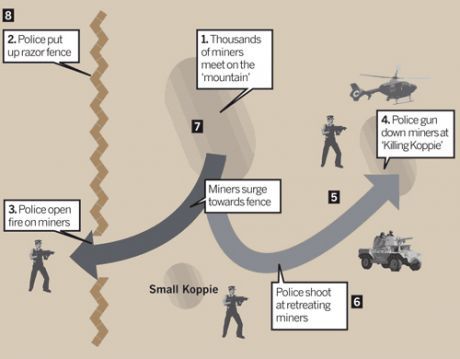News
You are here
34 South African miners shot down by police in cold blood

August 23, 2012
The world was shocked by TV images last week of striking South African miners being mowed down by police gunfire. But the truth behind the massacre is even more shocking.
The slaughter was not a tragic error of judgement. It was deliberate. The state forces were not protecting themselves from armed workers. They were executing a premeditated plan. And the striking miners were not charging at the police when they were shot down. They had already been surrounded and were running away from police firing behind them.
This is the picture that emerges from eyewitness testimony and examinations of the site by a team of Johannesburg-based researchers. One of the strike leaders said, “We were being shot at as if we were criminals. But we never stole from anyone. All we wanted was our right to a better life and better working conditions.”
Another strike leader describes a meeting with police before the massacre took place. “In our discussions they said they were sent by the government and had been given full rights to kill.”
Peter Alexander and the rest of the research team have written exclusively for Socialist Worker. The evidence they present has not yet appeared in the mainstream media.
Peter said the team’s investigation shows “that strikers were surrounded by heavily armed police and soldiers, and were killed while fleeing from gunfire”.
Thapelo Lekgowa, Botsang Mmope and Peter Alexander investigate the scene of the killing
Strikers were surrounded by heavily armed police and soldiers, and killed while fleeing from gunfire. The state forces were not “protecting themselves”. They participated in well-organised, premeditated slaughter.
We interviewed surviving miners and looked at physical evidence on the site of the massacre. What we found is even more shocking than the story presented in the media, even here in South Africa. Follow numbered events on the map above.
1: On the day of the killing about 3,000 striking miners were gathered on and just below the “mountain” (actually a small hill). Joseph Mathunjwa, president of their union, the AMCU, came and pleaded with them to leave to avoid a police attack. The miners refused.
2: Within 15 minutes of Mathunjwa leaving, the police and army laid razor wire, separating the strikers from the Enkanini informal settlement, where many of them live. Casspirs (armoured cars), horses and water cannon moved up to encircle the workers.
3: Some workers walked down to the razor wire to see if they could still get out through a gap. Witnesses say police near the “small koppie” (hillock) opened fire on them, probably with rubber bullets.
Some workers fled through a five metre gap in the razor wire. They were met with a barrage of live fire from the police and many died. Images of this shooting were broadcast around the world.
4: Terrified strikers scattered in all directions, with a large number heading for cover by a koppie about 300 metres in the opposite direction from the wire. This “killing koppie” is where the largest number of strikers died.
No cameras recorded this slaughter. But evidence remained on Monday, four days after the massacre. There are remnants of pools of blood. Police markers show where corpses were removed. We found markers labelled with letters up to ‘J’.
5-8: Other strikers were killed as they fled across the fields. Some examples are marked on the map. Shots were fired from helicopters and some workers, heading for hillock, were crushed by Casspirs.
By Monday the whole area had been swept clean of rubber bullets, bullet casings and tear-gas canisters. We also saw patches of burned grass, which local workers claim are the remains of police fires used to obscure evidence of deaths.
Originally published in Socialist Worker (UK) .
Section:
Topics:
- Log in to post comments










